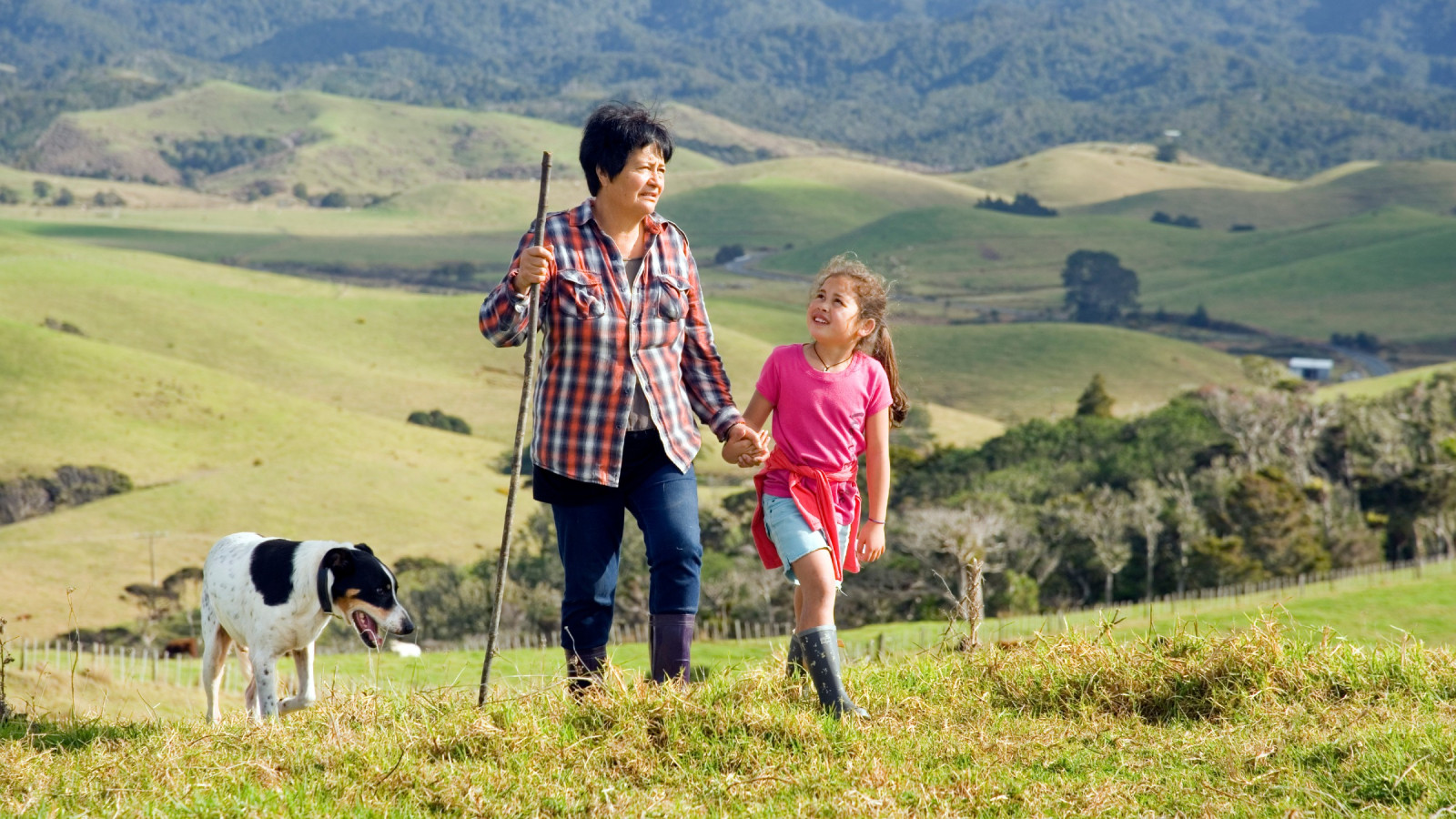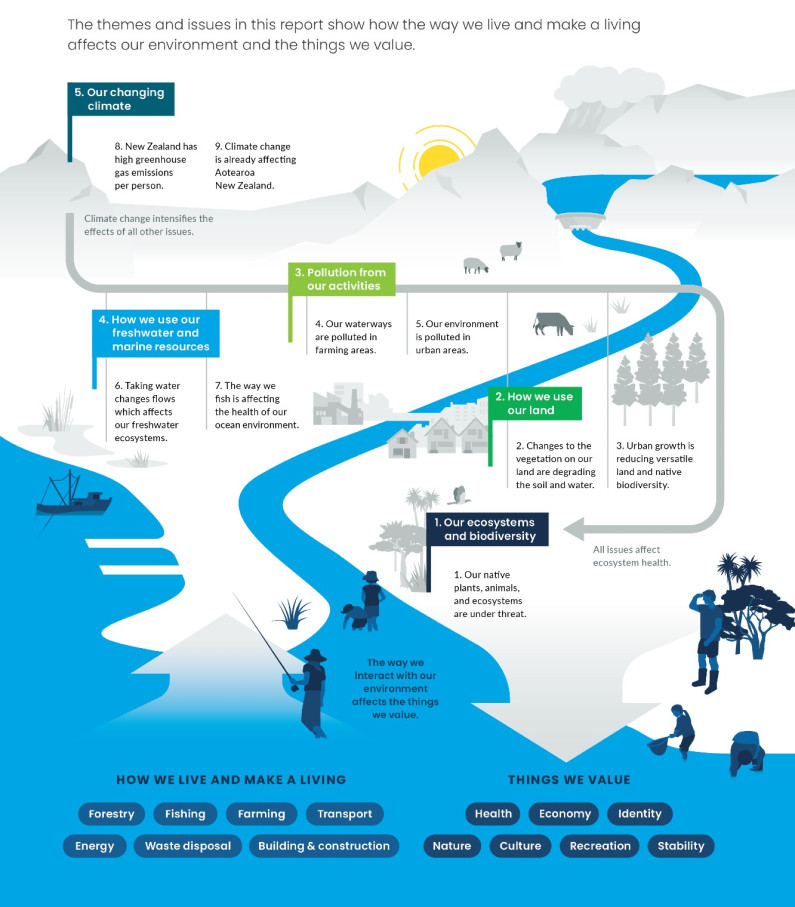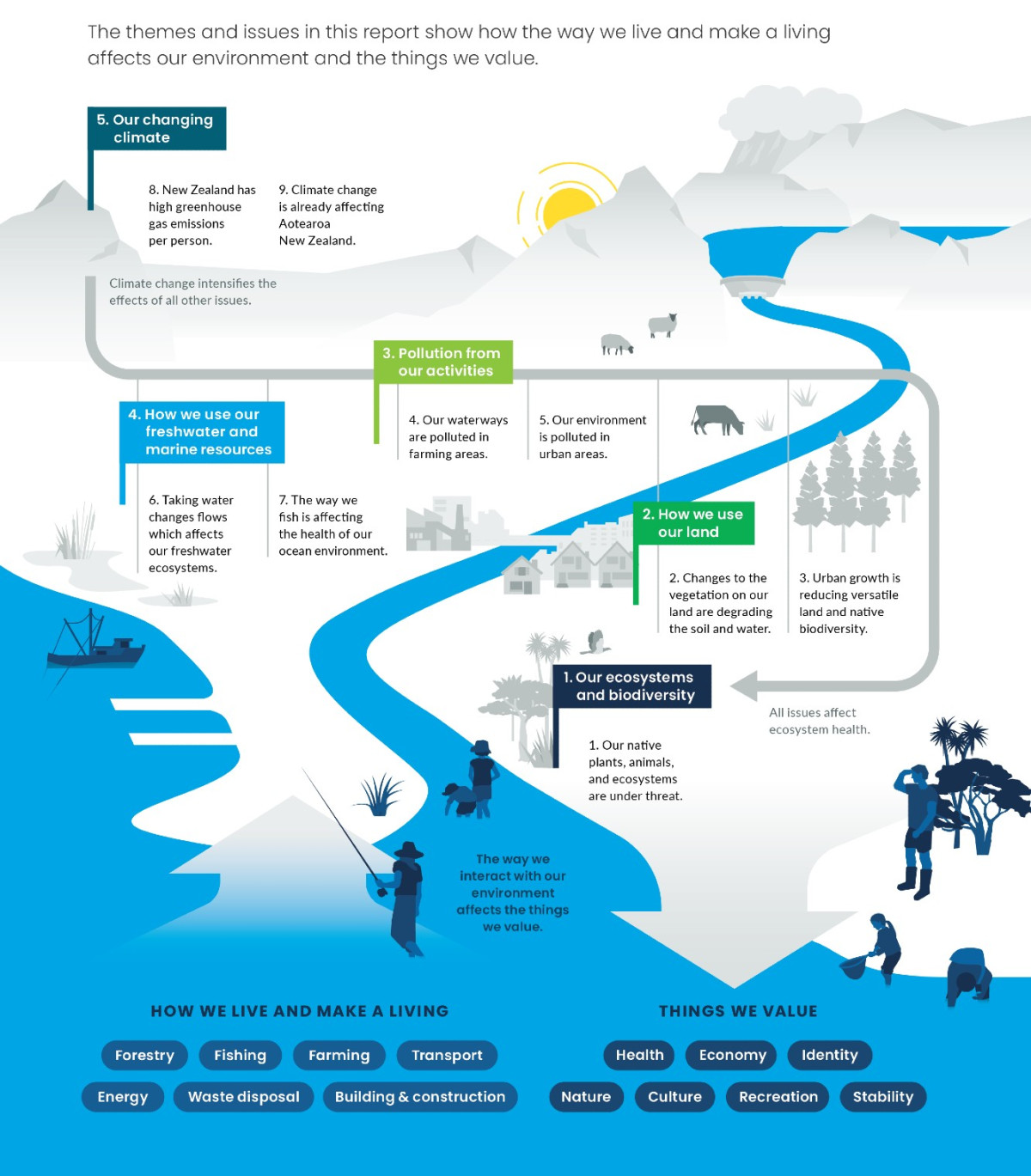About Environment Aotearoa 2019

This part of the report sets the scene and explains the approach – including how the nine priority issues were chosen. Scope, context, and governing legislation are also presented here.

Image: photonewzealand
The green of a kākāpō feather, scarlet pōhutukawa, summer cicada song, and a dolphin’s silver flash – these are the colours and sounds of our Aotearoa New Zealand.
Our land and sea are unique and very special, having evolved so distinctly and separately from the rest of the world. From the time our ancestors first stepped onto its shores, the land of the long white cloud has provided nourishment, protection, and resources to its inhabitants. People have become part of the environment and shaped it, modifying the land to grow food, building houses, and establishing settlements, roads, and infrastructure.
The relationship and connection we have with the environment goes well beyond the goods and services we receive from it, like food, fuel, and clean water. Our environment is where we stand, our tūrangawaewae – where we live, learn, work and earn a living, play, and socialise. It is our home and our identity, and the foundation
of our national culture and tradition.
As tangata whenua – people of the land – Māori have a distinct and special connection to the land. Māori identity, well-being, knowledge, and language systems, and the ways the culture is nourished, are indivisible from the health of Papatūānuku, the Earth Mother.
The whakapapa Māori have with the environment embeds humans in the environment. It ensures the unique connection of tangata whenua is respected and brings a way of thinking that helps us all see ourselves as a part of, not apart from, the environment.
Te ao Māori, the Māori world view, has an important place in environmental reporting in New Zealand and is intended to be a significant voice in this report. Wherever possible, it has been given space to speak about the state of the environment. We recognise that there is no one voice of Māori, nor are the voices presented in Environment Aotearoa 2019 as strong as they could be.
The relationship New Zealanders have with the environment is dynamic, but the ways we are modifying natural ecosystems to meet our needs in 2019 are having profound effects. Some parts of our environment are in good shape, others less so.
How we go forward from here is up to all of us.
This report is different to the Ministry for the Environment and Stats NZ’s regular six-monthly reports that cycle air, freshwater, marine, atmosphere and climate, and land domains. It is a synthesis report – bringing together all the domain reports to help us step inside and view our environment as a whole, in all its complexity.
The Environmental Reporting Act of 2015 (the Act) requires the Secretary for the Environment and the Government Statistician to produce such a synthesis state of the environment report every three years. Its purpose is to present ‘a diagnosis of the health of our environment’ to enable us as a nation, as iwi, as whānau, as communities, sectors, and individuals to understand the things that affect, or potentially affect the health of our environment. The last full report was Environment Aotearoa 2015 (before the Act), and before that versions in 2007 and 1997.
So while not suggesting responses (which are out of scope under the legislation), Environment Aotearoa 2019 provides evidence to enable an open and honest conversation about what we have, what we are at risk of losing, and where we can make changes.
The data used in Environment Aotearoa 2019 is drawn from the most recent domain reports (Our marine environment 2016, Our fresh water 2017, Our atmosphere and climate 2017, Our land 2018, and Our air 2018). The evidence base for this report is drawn from a set of environmental indicator web pages that are available on the Stats NZ website. Of the environmental indicators used in this report, 18 are new or have been updated since they were last used in a domain report, as new data has become available. (See the Environmental indicators section for links to all new and existing indicators referred to in this report.)
To provide the best picture in this report, including of emerging concerns, the report also draws on a body of evidence, such as government reports and peer-reviewed science papers. While the report tells a national story, it acknowledges important regional variations where possible.
As per the Act, state, pressure, and impact are used to report on the environment. The logic of the framework is that pressures cause changes to the state of the environment, and these changes have impacts. Impacts to ecological integrity, public health, economy, te ao Māori, culture, and recreation are described, as recommended under the Act.
The timeframes used throughout the report are largely dictated by the data that is available. Where possible, data is used to highlight significant periods of change. The time before humans arrived is sometimes used as a benchmark when the concept of ‘departure from natural conditions’ is discussed, to help characterise the significance of change.
In this report we have used the term ‘farming’ to refer to pastoral farming (including dairy, beef, sheep, and other livestock), horticulture, and arable cropping. When quoting from the body of evidence, we have used the term ‘agriculture’ to describe the same activities, where it is a direct quote from the source document.
Although the report does not specifically address uncertainty in measurements or conclusions in most instances, it acknowledges that it is present in all data and analysis. Where there is enough uncertainty to significantly impact the understanding of an issue it is highlighted as a knowledge gap.
This report has three main parts:
Our environment holds people, plants, animals, soil, fresh water, seas, and sky. In the domain reports, we explore just one element of the environment by considering its state, how it is changing, and the impacts these changes will have. In this synthesis report, however, five broad themes are used to look beyond single domains to the whole interconnected system.
An ecosystem describes a community of people, plants, and animals and how it interacts with a physical environment, like soil, water, and air. Ecosystems provide many benefits that are integral to our well-being. These include goods and services like food, recreation, pollination, and erosion control. Biodiversity is one of the main health indicators for ecosystems.
The way we use our land and what happens when we change from one land use to another can have significant effects on the health of our ecosystems, and the benefits we get from them. Effects can be on the land itself but also extend to connected streams, estuaries, and seas.
Our environment is polluted when substances (waste, nutrients, contaminants) and energy (heat, sound, radioactivity) are added faster than they can be dispersed, recycled, decomposed, or stored. Since many ecosystem processes operate as cycles (nutrients, water) pollutants canhave long-lasting effects on ecosystems and our well-being.
Our rivers, lakes, estuaries, and oceans are valued for their ecosystems and the services and resources they provide. The way we interact with these resources (taking water for irrigation, fishing for example) can compromise the health of the ecosystems and their ability to provide the cultural and socio-economic benefits we depend on.
Climate, and changes in climate, are affecting every ecosystem and some of the things we value. Here, our role as both influencers and recipients of climate is explored. Placing climate change as the final theme is also a chance to show how this unprecedented global disruption will affect every other issue.


Read the long description for Environment Aotearoa 2019 themes and issues
The themes and issues in this report show how the way we live and make a living affects our environment and he things we value.
The way we interact with our environment affects the things we value.
When reviewing Environment Aotearoa 2015, the Parliamentary Commissioner for the Environment (PCE) suggested structuring future synthesis reports around issues, where an issue is defined as:
…a change in the state of the environment that is (partly) caused by human activities (pressures) and has consequences (impacts).
A focus on issues was adopted for this report. It has enabled different environmental concerns to be prioritised individually but it also demonstrates how a single issue can cross many domains.
There are many environmental issues in our country. To narrow down the issues to those included here, findings from each of the five most recent domain reports were reviewed, ranked, and prioritised. Four criteria were established to help describe the sense of significance and urgency of the issue:
These criteria were informed by the suggestions of the PCE in The state of New Zealand’s environment: Commentary by the Parliamentary Commissioner for the Environment on Environment Aotearoa 2015 and are consistent with the selection criteria used to highlight the top findings in the domain reports.
The four criteria plus an indication of related knowledge gaps are used to summarise why each issue matters.
An independent panel of scientists verified the selection process to ensure criteria were appropriately applied against the issues. The relevance of the nine issues to mātauranga Māori, kaitiakitanga, and other cultural values was also considered by Māori researchers and practitioners.
The priority issues are not an exhaustive list of all the pressures our environment faces. Some have an impact on the environment but are not featured in this report as they do not rank as highly against the criteria as other issues. Mining for example, is not included because of its localised nature.
This report and all the associated indicator pages, graphics, and summary have been compiled by a team of scientists and data analysts from the Ministry for the Environment and Stats NZ.
Early in the project an independent science panel, composed of four of New Zealand’s top scientists, was established through a competitive process.
The panel, chaired by the Departmental Chief Science Advisor, advised and provided independent review of the structure, all content, and findings.
Where limited national data was available, more information has been provided using a ‘body of evidence’ approach. This approach looks across the science system and draws on the scientific literature and the combined results of multiple scientific studies to support findings.
To keep pace with developments since previous reports, some new data is included and different methods for collecting and interpreting data is presented (eg measuring trends for water quality).
All data used, as well as the body of evidence references have been corroborated and checked for consistency.
A steering group, representing both Ministry for the Environment and Stats NZ, provided oversight to ensure Environment Aotearoa 2019 was produced in a way that is transparent and robust, and can therefore be a valuable and trusted source of information.
As an issue is defined as a change in the state of the environment, caused by human activities (pressures) and having consequences (impacts), some environmental problems are not included. An example is plastic waste, which is considered as a pressure but not an issue, despite recently being ranked as the number one environmental concern by the public (Colmar Brunton, 2019).
Each issue addresses six questions:

About Environment Aotearoa 2019
April 2019
© Ministry for the Environment